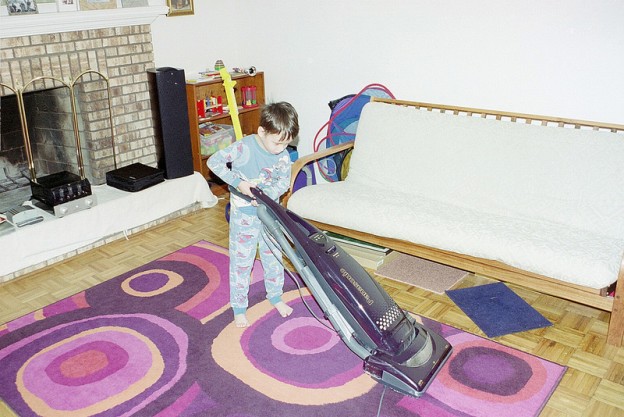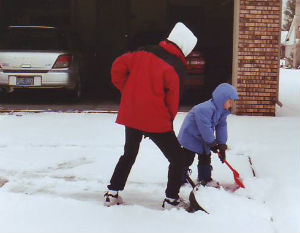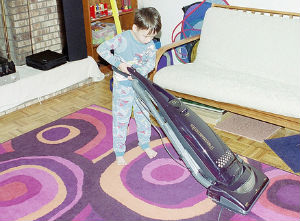
Parenting  I was chatting with another parent at the Friendship Circle recently, and I mentioned that my 10 year old son, who has autism and severe learning disabilities, does the dishes at our house.
“What? He does chores?”
Yes, in fact, Louie also does the laundry without being asked. And he vacuums his room. And he puts away his own clothes, books and toys. And he shovels snow. He does everything with a big smile.
I was chatting with another parent at the Friendship Circle recently, and I mentioned that my 10 year old son, who has autism and severe learning disabilities, does the dishes at our house.
“What? He does chores?”
Yes, in fact, Louie also does the laundry without being asked. And he vacuums his room. And he puts away his own clothes, books and toys. And he shovels snow. He does everything with a big smile.
 We added a new job to his chart as soon as he mastered the previous task. We talked openly about how everyone in the family was benefiting from Louie’s assistance.
Every shelf in Louie’s closet was labeled, and every evening I gave him 10 items of his clothing to identify and place on the correct shelf. The single most challenging task for Louie was to pick up 10 toys or books off the floor and to put each item back in the correct place. This required categorizing items out of context.
Step #5: Work on new tasks together
Our weekend outings taught Louie the value of shared activities. He noticed that my husband and I were finishing up the dishes after he unloaded the dishwasher, and he noticed the time spent doing laundry.
Louie decided that he wanted to be more involved, because it meant that he could spend more time with his parents. This was a major turning point for him. He started loading the dirty clothes in the washing machine, and I taught him how to measure the detergent and switch on the machine. He loved setting and turning on the machine.
Step #6: Practice makes perfect!
Scaffolding is the art of putting supports in place so that a person can learn a new skill. Louie needed plenty of scaffolding to learn how to load dirty dishes into the dishwasher.
He had to learn how to rinse, sort and arrange everything. He spilled an awful amount of dirty dishwater on the kitchen floor and counters. We often had to run the dishwasher twice to get everything clean. But we responded positively and showed him the correct way to load. Even the lightest, most gentle criticism was upsetting to him.
Step #7: Remove the Scaffolding
We slowly removed the scaffolding from the daily chores and invited Louie to join us in whatever we were doing.
He doesn’t have a job chart anymore. Louie loves to help me prepare meals: he prefers to set the oven for me, because pressing electronic buttons is such a delight. He learned how to sort our dirty laundry into whites, colors and delicates.
Last weekend he wanted to watch his dad change the oil in the car. We keep adding new tasks to his repertoire, and we make sure that the experience is social and lighthearted. Louie has a long way to go in his developmental skills, but every day I kiss him and say, “Thank you for helping me today.”
We added a new job to his chart as soon as he mastered the previous task. We talked openly about how everyone in the family was benefiting from Louie’s assistance.
Every shelf in Louie’s closet was labeled, and every evening I gave him 10 items of his clothing to identify and place on the correct shelf. The single most challenging task for Louie was to pick up 10 toys or books off the floor and to put each item back in the correct place. This required categorizing items out of context.
Step #5: Work on new tasks together
Our weekend outings taught Louie the value of shared activities. He noticed that my husband and I were finishing up the dishes after he unloaded the dishwasher, and he noticed the time spent doing laundry.
Louie decided that he wanted to be more involved, because it meant that he could spend more time with his parents. This was a major turning point for him. He started loading the dirty clothes in the washing machine, and I taught him how to measure the detergent and switch on the machine. He loved setting and turning on the machine.
Step #6: Practice makes perfect!
Scaffolding is the art of putting supports in place so that a person can learn a new skill. Louie needed plenty of scaffolding to learn how to load dirty dishes into the dishwasher.
He had to learn how to rinse, sort and arrange everything. He spilled an awful amount of dirty dishwater on the kitchen floor and counters. We often had to run the dishwasher twice to get everything clean. But we responded positively and showed him the correct way to load. Even the lightest, most gentle criticism was upsetting to him.
Step #7: Remove the Scaffolding
We slowly removed the scaffolding from the daily chores and invited Louie to join us in whatever we were doing.
He doesn’t have a job chart anymore. Louie loves to help me prepare meals: he prefers to set the oven for me, because pressing electronic buttons is such a delight. He learned how to sort our dirty laundry into whites, colors and delicates.
Last weekend he wanted to watch his dad change the oil in the car. We keep adding new tasks to his repertoire, and we make sure that the experience is social and lighthearted. Louie has a long way to go in his developmental skills, but every day I kiss him and say, “Thank you for helping me today.”
How To Teach Chores To Your Special Needs Child
 I was chatting with another parent at the Friendship Circle recently, and I mentioned that my 10 year old son, who has autism and severe learning disabilities, does the dishes at our house.
“What? He does chores?”
Yes, in fact, Louie also does the laundry without being asked. And he vacuums his room. And he puts away his own clothes, books and toys. And he shovels snow. He does everything with a big smile.
I was chatting with another parent at the Friendship Circle recently, and I mentioned that my 10 year old son, who has autism and severe learning disabilities, does the dishes at our house.
“What? He does chores?”
Yes, in fact, Louie also does the laundry without being asked. And he vacuums his room. And he puts away his own clothes, books and toys. And he shovels snow. He does everything with a big smile.
“How did you teach him to do all of that?”
Well, it took a really long time for him to learn. We had to find the right motivation, and we had to break everything down into simple steps. But somehow it clicked. This is how the learning process unfolded for us. Step #1: Start with Self Care My husband and I started to make long-term plans for our son while he was still in preschool. We realized that he was going to need extra help learning basic life skills. We introduced self-care: brushing his own teeth, running a bath at the right temperature, washing his body. We always made it a point to comment positively on his independence in this area, but we did not give him any other reward. Step #2: Experiment with Sticker Charts We tried sticker charts for doing tasks around the house. The list of chores would have one or two self-care tasks, a household task that he had already mastered and a household task that he had not yet mastered. Our son had absolutely no interest in these sticker charts for several years. But we noticed that he liked to vacuum and switch electric items on and off. We decided to let him vacuum as much as he wanted, and we even got him a Shark motorized sweeper, because it is lighter and quieter than a regular vacuum. Step #3: Incorporate Privileges Eventually, Louie started asking for extra privileges. His most prized privilege was a weekend morning out with either me or my husband. Those sticker charts suddenly became attractive. His first successful job chart only had 2 jobs on it: read 20 minutes per day with Mom and unload the clean dishes from the dishwasher with Dad. This involved re-organizing the kitchen so that all dishes were accessible to him. We had to talk him through the unloading process and show him the correct place for every single item. Step #4: Add one task at a time We added a new job to his chart as soon as he mastered the previous task. We talked openly about how everyone in the family was benefiting from Louie’s assistance.
Every shelf in Louie’s closet was labeled, and every evening I gave him 10 items of his clothing to identify and place on the correct shelf. The single most challenging task for Louie was to pick up 10 toys or books off the floor and to put each item back in the correct place. This required categorizing items out of context.
Step #5: Work on new tasks together
Our weekend outings taught Louie the value of shared activities. He noticed that my husband and I were finishing up the dishes after he unloaded the dishwasher, and he noticed the time spent doing laundry.
Louie decided that he wanted to be more involved, because it meant that he could spend more time with his parents. This was a major turning point for him. He started loading the dirty clothes in the washing machine, and I taught him how to measure the detergent and switch on the machine. He loved setting and turning on the machine.
Step #6: Practice makes perfect!
Scaffolding is the art of putting supports in place so that a person can learn a new skill. Louie needed plenty of scaffolding to learn how to load dirty dishes into the dishwasher.
He had to learn how to rinse, sort and arrange everything. He spilled an awful amount of dirty dishwater on the kitchen floor and counters. We often had to run the dishwasher twice to get everything clean. But we responded positively and showed him the correct way to load. Even the lightest, most gentle criticism was upsetting to him.
Step #7: Remove the Scaffolding
We slowly removed the scaffolding from the daily chores and invited Louie to join us in whatever we were doing.
He doesn’t have a job chart anymore. Louie loves to help me prepare meals: he prefers to set the oven for me, because pressing electronic buttons is such a delight. He learned how to sort our dirty laundry into whites, colors and delicates.
Last weekend he wanted to watch his dad change the oil in the car. We keep adding new tasks to his repertoire, and we make sure that the experience is social and lighthearted. Louie has a long way to go in his developmental skills, but every day I kiss him and say, “Thank you for helping me today.”
We added a new job to his chart as soon as he mastered the previous task. We talked openly about how everyone in the family was benefiting from Louie’s assistance.
Every shelf in Louie’s closet was labeled, and every evening I gave him 10 items of his clothing to identify and place on the correct shelf. The single most challenging task for Louie was to pick up 10 toys or books off the floor and to put each item back in the correct place. This required categorizing items out of context.
Step #5: Work on new tasks together
Our weekend outings taught Louie the value of shared activities. He noticed that my husband and I were finishing up the dishes after he unloaded the dishwasher, and he noticed the time spent doing laundry.
Louie decided that he wanted to be more involved, because it meant that he could spend more time with his parents. This was a major turning point for him. He started loading the dirty clothes in the washing machine, and I taught him how to measure the detergent and switch on the machine. He loved setting and turning on the machine.
Step #6: Practice makes perfect!
Scaffolding is the art of putting supports in place so that a person can learn a new skill. Louie needed plenty of scaffolding to learn how to load dirty dishes into the dishwasher.
He had to learn how to rinse, sort and arrange everything. He spilled an awful amount of dirty dishwater on the kitchen floor and counters. We often had to run the dishwasher twice to get everything clean. But we responded positively and showed him the correct way to load. Even the lightest, most gentle criticism was upsetting to him.
Step #7: Remove the Scaffolding
We slowly removed the scaffolding from the daily chores and invited Louie to join us in whatever we were doing.
He doesn’t have a job chart anymore. Louie loves to help me prepare meals: he prefers to set the oven for me, because pressing electronic buttons is such a delight. He learned how to sort our dirty laundry into whites, colors and delicates.
Last weekend he wanted to watch his dad change the oil in the car. We keep adding new tasks to his repertoire, and we make sure that the experience is social and lighthearted. Louie has a long way to go in his developmental skills, but every day I kiss him and say, “Thank you for helping me today.” 


